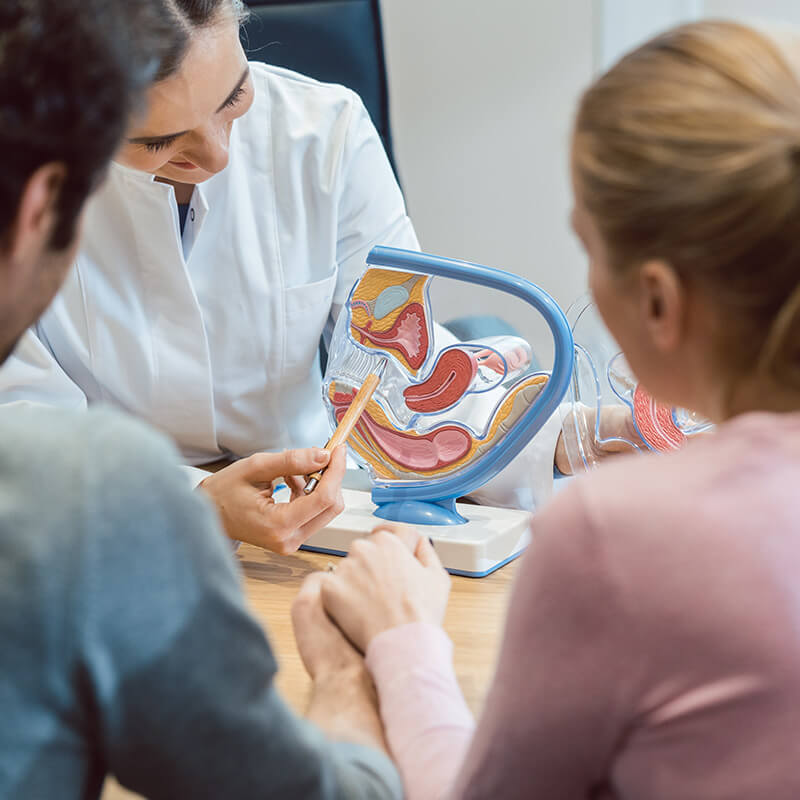
In talking with your doctor about your symptoms or during a diagnostic procedure such as laparoscopy or hysteroscopy, it may be determined that you have fibroids. These benign (non-cancerous) tumors made up of smooth muscle cells and connective tissue develop in the uterus, causing discomfort and potential infertility. The procedure to remove these tumors is called myomectomy.
Fibroids & Pregnancy
If you are aware that you have fibroids and you are trying to conceive, you may be concerned about the implications of fibroids and pregnancy. With an estimated 70-80% of women developing fibroids at some point in their lives, odds are that your fibroids will not interfere with pregnancy. However, if they change the shape or structure of your uterus, or if there are many or large fibroids, it may be difficult for an a fertilized egg (embryo) to implant successfully. Your doctor can determine if this is the case and if a myomectomy might help.
What symptoms warrant a myomectomy?
While most women with uterine fibroids have no symptoms, some will experience symptoms that are uncomfortable or affect their daily activities. If you have any of these symptoms due to fibroids, a myomectomy can bring relief.
Myomectomy Symptoms:
- Heavy or prolonged periods
- Spotting or bleeding between periods
- Pelvic pain and pressure
- Low back pain
- Pain during intercourse
- Frequent urination
- Difficulty getting pregnant
- Multiple miscarriages

Types of Myomectomy
There are three types of myomectomy procedures: hysteroscopic, laparoscopic, and abdominal. Each type accesses your uterus in a different way, and each vary in level of invasiveness.
Hysteroscopic Myomectomy
The least invasive type of myomectomy is a hysteroscopic myomectomy. This procedure can be performed in your doctor’s office or in a hospital setting, and you can go home the same day. Typically used to treat smaller fibroids that bulge significantly into your uterus (submucosal fibroids), hysteroscopic myomectomy involves placing a hysteroscope (a long, telescope-like instrument) and fibroid-removing tools through your vagina and cervix into your uterus. If fibroids are large, they may require a second surgery for full removal. See related: laparoscopy & hysteroscopy
Laparoscopic Myomectomy
The second type of procedure to remove fibroids is a laparoscopic myomectomy. This minimally invasive procedure involves a few small abdominal incisions through which your surgeon will place a camera and the tools necessary to remove your fibroids. While performed in a hospital under general anesthesia, this procedure is typically outpatient or may only require a one-night hospital stay. See related: laparoscopy & hysteroscopy
Abdominal Myomectomy
Abdominal myomectomy is the most invasive but complete type of myomectomy. During an abdominal myomectomy, your surgeon will make a horizontal incision along your bikini line (lower abdomen) to access your uterus and remove the fibroids. This major surgery is performed under general anesthesia and requires a short hospital stay.

Myomectomy Results & Recovery

Myomectomies are typically successful in improving fibroid symptoms, with women reporting decreased menstrual bleeding and pelvic pressure. Recovery time will vary depending on the type of myomectomy you have, but expect to have some vaginal spotting that can last anywhere from a few days up to six weeks.
Does myomectomy improve fertility?
Myomectomy surgery can improve your fertility. Studies have shown that pregnancy rates may improve after myomectomy for women with submucosal fibroids (as they distort the structure of the uterine cavity), but the evidence that it will improve fertility for fibroids in other locations is unclear.
Women who have laparoscopic myomectomies have been shown to have good pregnancy outcomes within about a year of surgery. However, it is important to wait at least three to six months after a myomectomy before trying to conceive in order to allow your uterus to heal.
Is myomectomy for me?
If you are experiencing fibroid symptoms, then it is likely that a myomectomy can bring relief. However, if you are experiencing infertility without fibroid symptoms, it may not be necessary or helpful to have a myomectomy.
If your infertility is otherwise unexplained, your doctor may perform a diagnostic hysteroscopy to look for fibroids that might be impairing your ability to get pregnant. Fibroids that distort the uterine cavity or severely alter your pelvic architecture may affect an egg’s implantation or development, and/or it may not be possible to retrieve eggs for use in in vitro fertilization (IVF) without removing them.
We can offer relief!
If you’re experiencing pain or discomfort during your menstrual cycle or if you have heavy or intermittent bleeding, make an appointment with us for an evaluation. Dr. Stephan Krotz will walk you through your options and offer the best path toward fertility. Give us a call today at 713-401-9000 to schedule your fertility evaluation.
